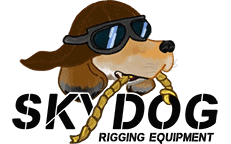Chain Terms, Warnings & Specifications
Working Load Limit: The “Working Load Limit” is also commonly abbreviated as “WLL”. It is the maximum load in pounds which should ever be applied to a chain, fitting or block when the load is uniformly applied in direct tension. Straight line pull only.
Skydog Rigging Equipment does not accept any liability for damages or injuries resulting from the use of chain or accessories in excess of the “Working Load Limit” or “WLL”.
Proof Test: This term describes a specific tensile test which the item has been subject to during or subsequent to the process of manufacture. It is the load in pounds at which the chain, fitting or block has been pulled in direct tension using a standard pull testing machine.
Minumum Ultimate Load: The minimum load in pounds at which the chain, fitting or block, in the condition it would leave the factory, has been found to break when tested with a constantly increasing force applied in direct tension to a straight length of chain, fitting or block.
WARNINGS AND CAUTIONS:
- Never exceed the WLL “Working Load Limit” of the chain, fittings or blocks.
- The working load limit (see definition) refers to a load that is uniformly applied in direct tension to the product. It can be significantly reduced if not used in the proper application. The following are some examples of improper use and should be avoided when using chain and accessories:
Twisting or tying the chain in a knot. Jerking or shock loading the load.
Gouging, bending, or other disfigurement of chain links and attachments.
Environments with high corrosion or other extreme conditions
Any use or purpose for which the product was not designed or intended to be used for. - Use ONLY GRADE 80 ALLOY chain and accessories for overhead lifting.
- Always inspect chain before and after using it.
SPECIFICATIONS:
All of our chain, fittings and blocks are made in accordance with the current federal, military, industry, A.S.T.M. and the N.A.C.M. norms where specified. Link dimensions of chain will vary by manufacturer and specification. Note that these norms specify different safety factors for different types and grades of chain, fittings and blocks. For the most commonly sold chains these are:
Working Load Limit (WLL) to Ultimate load:
1:4 GR-80 ALLOY, GR-70 TRANSPORT, GR-28 PROOF COIL
1:3 GR-43 HIGH TEST
INSTRUCTIONS REGARDING ATTACHMENTS
All attachments and accessories are designed for use with the appropriate size chain or wire rope. Always make sure that the attachment is at least equal to the strength of the chain or wire rope. A CHAIN OR WIRE ROPE ASSEMBLY SHALL ONLY BE RATED TO THE CAPACITY OF THE WEAKEST COMPONENT IN IT.
HALLMARKING
All our products conform to U.S. CUSTOMS laws requiring that country of origin be marked on all import products. In addition all grades of chain are marked at various intervals.
VARIATIONS IN FINISH OR HEAT TREATMENT
The mechanical properties listed on this website apply only to the various items in their standard finish and heat treat condition. Finishes such as hot galvanizing or electro galvanizing may reduce the strengths.
CHAIN MAINTENANCE AND INSPECTION
It is necessary to inspect chain slings and load chains on a regular basis and keep records of the inspection. Inspections shall include end attachments and the chain on an individual link basis. The chain sling or load chain should be cleaned prior to inspection to aid in the detection of undesirable conditions.
Things to look for during the inspection:
Marks, nicks, gouges, cracks
Wear, especially excessive wear at the bearing points
Twists or bends
Stretch
Distortion
Detection of any of these conditions must be resolved before a chain sling or load chain may be put back into service.
FITTINGS MAINTENANCE AND INSPECTION
Fittings, including hooks, shackles, links, etc., may become worn and disfigured over time, resulting in nicks, gouges and/or sharp corners which produce additional stress conditions. Regular inspection is recommended to monitor product condition. Grinding is the recommended procedure to restore smooth surfaces. If the product dimensions are altered it may necessitate a change in Working Load Limit. Any crack or deformation in a fitting is sufficient cause to withdraw the product from service.
